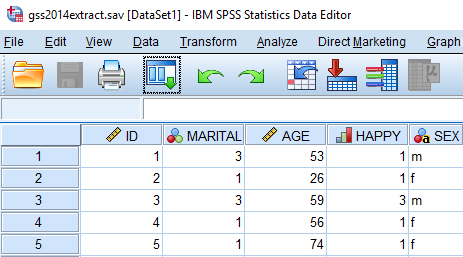Example of combining cases using ADD FILES
In this example, we have GSS2014 and GSS2016 files that have some variables in common. Using ADD FILES, we create a combined file.
Following is a screenshot of the first five rows of data from a GSS2014 extract:

The file has 2,538 rows and five variables.
Here is a screenshot of the first five rows of data from a GSS2016 extract:

The file has 2,867 row and 29 variables.
Suppose that you wish to combine the files. While the 2016 image does not show all the fields, it turns out that the 2016 file has the same five variables as the 2014 file (along with many others). Considering the five variables in more detail, there are a couple things to take care of in the merge.
First, the ID fields have duplicate values across the two files because the ID numbers are internal to each file. In this situation, you should take some action to make the ID values unique across files. An easy thing to do is add a number to the IDs in one or both files. We illustrate this...







































































